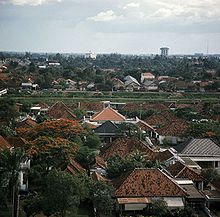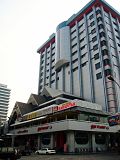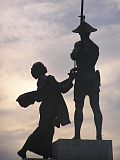- Menteng
-
Menteng is a subdistrict of Central Jakarta, one of the administrative city which forms the special capital territory of Jakarta, Indonesia.
The subdistrict is best known as the location of the Menteng residential area, a new urban design developed in the 1910s to become a residential area for Dutch people and high officials. Supported by easy access to service centers and nearby to the central business district, this area has become one of the most expensive areas for residential real estate in Jakarta. Several important people such as former president Suharto take up residence in Menteng. The President of the United States Barack Obama spent his childhood in Menteng, attending local schools including Besuki Public School and St. Francis of Assisi School.[1][2][3]
Menteng Subdistrict is located to the south of Merdeka Square. It is roughly bounded by Kebon Sirih Road to the north, a canal to the west, the canal Kali Malang to the south, and the river Ciliwung to the east.
Menteng Subdistrict is served by several railway stations (e.g. Gondangdia Station, Sudirman Station, Cikini Station, and Mampang Station. Mohammad Husni Thamrin Road is the main artery of Jakarta, which lies on the west part of Menteng Subdistrict.
Contents
Menteng residential area
 The office building of N.V. de Bouwploeg, now the Cut Mutiah mosque
The office building of N.V. de Bouwploeg, now the Cut Mutiah mosque
Menteng residential area is located in Menteng Subdistrict. The residential area spread over the administrative villages of Menteng and Gondangdia. Menteng residential area is the first modern housing estate in Jakarta. It was developed by the private real estate company N.V. de Bouwploeg, established by Pieter Adriaan Jacobus Moojen (1879 - 1955). At that time, the Menteng residential area was known then as Nieuw Gondangdia, and was designed by P.J.S. Moojen and F.J. Kubatz, a Dutch architect. The Nieuw Gondangdia, also known as Menteng Project, was started during the 1910s-1920s. The project was meant to be the southern expansion of the city Batavia.[4]
Menteng Project is designed following a hierarchical system that divides streets and houses into several classes. Parks cover about 30 percent of the area in 23 places (e.g. Suropati Park, Tugu Tani park, and Situ Lembang). A 1975 gubernatorial decree declared Menteng a cultural heritage area, citing its distinctive architecture, which often includes high, slanting roofs and ample gardens.[5] During the 1980s, the west part of Menteng was transformed into a commercial area, such as Sabang Street (now Agus Salim street), Jaksa Street, Teuku Cik Di Tiro Street, and Menteng Raya Street. Most of them changed into shops, hotels, offices, and restaurants. The Jalan Jaksa Festival is held every year in Jaksa Street.[6]
Presently, conservation of the Menteng residential area has shown many problems. Despite being a cultural heritage area, many houses were renovated into a Neoclassical style by newcomers, a style which has no relation with Menteng residential area. Authorities may stop the construction of a building which violate the Menteng style, but some projects resume until the houses are finished. Other problem related to the conservation of Menteng residential area are banning of businesses in the area despite the rising land taxes, fraud by architects of the newly renovated buildings, and the general lack of knowledge in conservation.[5]
The residences
The houses of Menteng were aimed for the Dutch or locals with higher status. The new residential area was segregated from the traditional dwelling (kampung) scattered around the area. Menteng Project was the first housing project in Jakarta that follows the first law of urban planning in Batavia, known as Bataviasche Bouwverordening.[7]
The architecture style of Menteng residential area was known as "Indies" or "Indo-European". It is characterized with tall pyramid-shaped roofs, front terraces, wide courtyard, characteristic textures in the wall, and other architectural forms such as windows, doors, and prominent air ventilation. The architectural style of the building in Menteng can be classified into Classicism/Old Indies, Nieuwe Zakelijkheid, New Indies, Art Nouveau and Art Deco, Amsterdam School, De Stijl, Le Corbusier and traditional Indonesian architecture.[7]
The residences of Menteng area was classified into several classes according to a recommendation by the Department of Civil Works (Burgerlijke Openbare Werken):
Mid-high class residences
The residence was classified as class 1 to 3. The houses of these type were built in the core area of Menteng and were targeted for high officials and high class Dutch or European civilians. The architecture style was known as "Transitional Period" (Overgangs periode), which is the style of architecture between the older "Old Indies House" style (Oud Indische Huis), with its typical wide courtyard and wide terraces, to the more modern style called the "European Villa". The area is connected with wide boulevards.[7]
Houses in this class are generally one or two floored free-standing house (hoofd gebouw) with one or two wings/pavilions attached to the main building.[7]
Mid-low class residences
The residence was classified as class 4 to 7. These are the most dominant type of houses in Menteng. The architecture style is a fusion between the Dutch Transitional Period houses and local traditional houses. The area is connected with narrower streets, classifed in Dutch as Laan, Straat or Weg.
Residence class 6 and 7 were targeted for the colonial government officials and was known as Land Woningen Voor Ambtenaren (Dutch "Country Houses for Officials"). Generally, these houses are one-floored and can sometimes be a semi-detached house (Dutch koppel).
Facilities
The master plan of Menteng included some facilities and infrastructures:
- N.V. de Bouwploeg Architects office, (now Cut Mutiah Mosque).
- Bataviasche Kunstkring (now a bar)
- Nassaukerk (now St.Paulus and Theresia Church).
- Gedung Ditjen Kebudayaan
- A school building (now in HOS. Cokroaminoto Street)
- Parks
Kelurahan (Administrative Villages)
The subdistrict of Menteng is divided into five kelurahan or administrative villages:
- Menteng - area code 10310
- The southern area of the Menteng Project.
- Pegangsaan - area code 10320
- Known as the location of the house where the Proclamation of Indonesian Independence was read.
- Cikini - area code 10330
- Kebon Sirih - area code 10340
- Gondangdia - area code 10350
- The northern area of the Menteng Project.
List of important places
- Canisius College
- Cut Mutiah Mosque
- Entertainment X'nter
- Gedung Joeang 45
- Gedung Perintis Kemerdekaan
- Gondangdia Station
- Grand Hyatt and Plaza Indonesia
- Hotel Indonesia, the first luxurious hotel in Indonesia and a landmark of Jakarta.
- Jakarta Theater
- Mandarin Hotel
- Megaria Theater (formerly Menteng Theater)
- Menara Thamrin
- Menteng Park (the site of the former Menteng Stadium)
- Selamat Datang Monument, in the middle of Bundaran HI (Hotel Indonesia)
- Museum of the Declaration of Independence (Museum Perumusan Naskah Proklamasi)
- Nikko Hotel
- Patung Pahlawan
- Sarinah (Graha Mataram)
- Sasmita Loka Ahmad Yani Museum
- St. Paul Church
- St. Theresia Church
- Sunda Kelapa Mosque
- Suropati Park
- Taman Ismail Marzuki
- Tugu Proklamasi (Monumen Proklamator)
References
- ^ "Statue of a Young Obama To Watch Over Indonesian Capital". The Jakarta Globe. 2009-12-09. http://thejakartaglobe.com/home/statue-of-us-president-barack-obama-to-be-unveiled-in-jakarta-park/346178. Retrieved 2010-02-19.
- ^ From Chinaview.cn
- ^ Obama Debunks Claim About Islamic School
- ^ A. Heuken & G.Pamungkas (2001). Menteng 'Kota Taman' pertama di Indonesia.
- ^ a b dis (August 3, 2009). [http://www.thejakartapost.com/news/2009/08/03/menteng-residents-want-more-say-heritage-plan.html "Jakarta Menteng residents want more say on heritage plan"]. The Jakarta Post. http://www.thejakartapost.com/news/2009/08/03/menteng-residents-want-more-say-heritage-plan.html. Retrieved November 19, 2011.
- ^ http://web.archive.org/web/20050508194401/http://www.kompas.com/kompas-cetak/0504/12/metro/1676614.htm
- ^ a b c d "Pedoman Perencanaan Bangunan Kawasan Pelestarian MENTENG". Dinas Penataan dan Pengawasan Bangunan - Pemrov DKI Jakarta. Dinas Penataan dan Pengawasan Bangunan - Pemrov DKI Jakarta. http://menteng-dppb.jakarta.go.id/awal.html. Retrieved 2010-02-23.
Administrative areas of the Special Capital Territory of Jakarta Cities and Regency of Jakarta Central Jakarta Cempaka Putih • Gambir • Johar Baru • Kemayoran • Menteng • Sawah Besar • Senen • Tanah Abang
West Jakarta Cengkareng • Grogol • Kalideres • Kebon Jeruk • Kembangan • Palmerah • Taman Sari • Tambora
South Jakarta Cilandak • Jagakarsa • Kebayoran Baru • Kebayoran Lama • Mampang Prapatan • Pancoran • Pasar Minggu • Pesanggrahan • Setiabudi • Tebet
East Jakarta Cakung • Cipayung • Ciracas • Duren Sawit • Jatinegara • Kramat Jati • Makasar • Matraman • Pasar Rebo • Pulo Gadung
North Jakarta Cilincing • Kelapa Gading • Koja • Pademangan • Penjaringan • Tanjung Priok
Thousand Islands See also: List of regencies and cities of Indonesia Categories:- Subdistricts of Jakarta
- Areas of Jakarta
- Regency capitals of Indonesia
Wikimedia Foundation. 2010.



